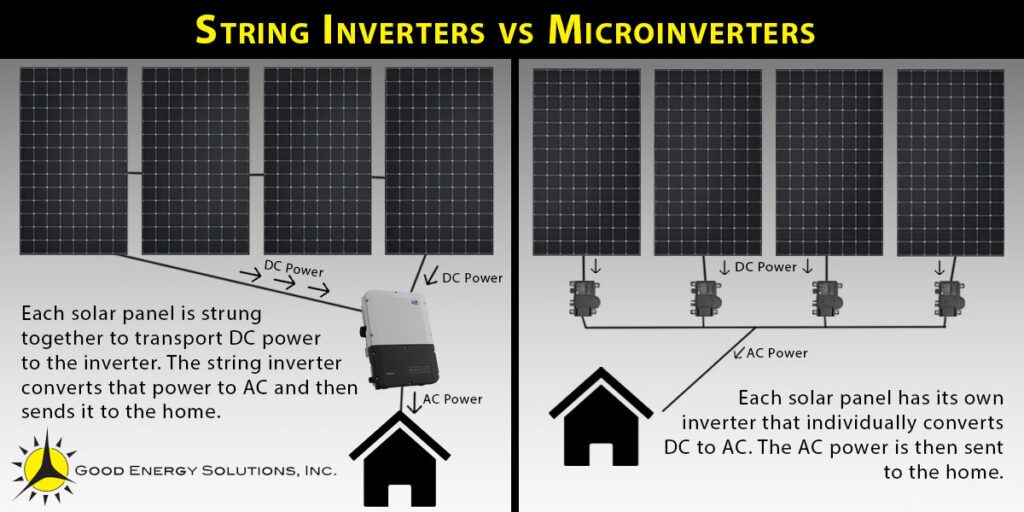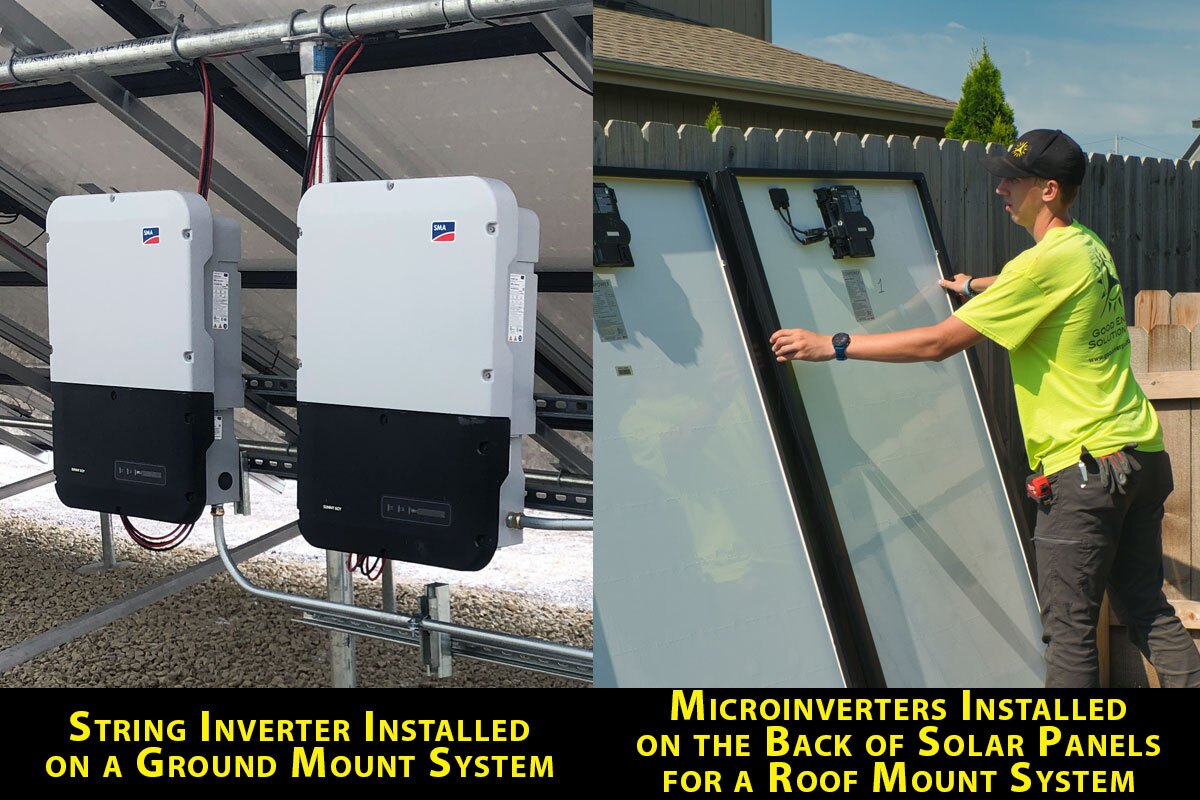One of the common questions we receive from people looking to add solar to their home or business is “Do I need a string inverter or microinverter for my solar installation?” Each option comes with its own pros and cons.
Let’s first take a look at why solar installations need inverters. When the sun hits solar panels made from silicon, an electrical charge is generated. That electrical charge is turned into DC electricity. Solar inverters convert direct current (DC) electricity produced by solar cells into usable alternating current (AC) electricity. Most appliances and electronics in your home or business run off of AC electricity. There are two types of inverters used for solar projects. String inverters and microinverters differ in terms of their design, functionality, and how they are connected to solar panels.
Here at Good Energy Solutions, we usually install string inverters for our ground mount projects, with microinverters used for roof-mounted solar installations. These are the key differences between string inverters and microinverters:
Inverter Location:
- String Inverters: Typically installed at a central location, often on a wall near the main electrical panel or close to an electrical meter for a roof mounted solar project. They are connected to multiple solar panels arranged in strings.
- Microinverters: Each microinverter is installed directly on the back of an individual solar panel or attached to the rail that the solar panel rests on. This means that each panel operates independently.

Panel Independence:
- String Inverters: Solar panels are connected in series (string), and the performance of the entire string is dependent on the output of the lowest-performing panel.
- Microinverters: Each solar panel operates independently, allowing for individual optimization and minimizing the impact of shading or malfunctions in one panel on the overall system.
System Performance:
- String Inverters: A single malfunctioning or shaded panel diminishes the output of the entire string since they are connected in series.
- Microinverters: Each panel operates independently, so shading or malfunctions in one panel have a smaller impact on the overall system performance.
Monitoring and Maintenance:
- String Inverters: Monitoring is typically done at the system level. If an issue arises, it may be more challenging to pinpoint the specific panel causing the problem. Panel level monitors can be accomplished with string inverters by incorporating DC optimizers into the system. Ground-mounted systems or installations mounted on flat roofs allow for easier access to the modules, making troubleshooting issues with the system less complicated and reduces the need for complex remote monitoring.
- Microinverters: Monitoring can be done at the individual panel level, allowing for more accurate diagnostics and easier maintenance. For systems mounted on a pitched roof, the modules will be harder to access, making remote monitoring of individual solar panels more crucial for maintenance.
Cost:
- String Inverters: Generally less expensive on a per-watt basis when compared to microinverters.
- Microinverters: Tend to be more expensive on a per-watt basis due to the additional electronics required for each panel.
Installation Complexity:
- String Inverters: Usually simpler to install as they involve a single inverter for the entire system. This also means fewer components are needed, leading to a lower cost.
- Microinverters: Installation involves mounting an inverter on the back of each solar panel or directly onto the racking, which can be more labor-intensive. Also, microinverters introduce more complexity into the design of a solar panel system, leading to a higher cost for the overall installation.
Efficiency:
- String Inverters: Efficiency can be impacted by shading or panel mismatches.
- Microinverters: Each panel operates independently, which can lead to higher overall system efficiency, especially in scenarios where shading is an issue.
Lifespan:
- String Inverters: Most have an expected lifespan of 10 years. Some string inverters have the option for additional warranty timelines up to 25 years depending on the manufacturer.
- Microinverters: The most popular microinverters, like the Enphase IQ8 series, come with a limited warranty of 5-10 years with an useful life of 20-25 years.
The choice between string inverters and microinverters often depends on factors such as system size, shading conditions, budget constraints, and individual preferences. With ground-mounted solar installations, string inverters typically make more sense as they rarely have to operate under shaded conditions with panel issues easier to diagnose and panels easier to service due to the array’s closer proximity to the ground. Microinverters tend to work better on roof-mounted solar installations as they allow for individual panel monitoring, allow for remote panel troubleshooting and protect against lost power generation due to shade issues or a failing solar panel.
Both types of inverters have their advantages and disadvantages, and the best choice for a particular solar power system depends on the specific circumstances and goals of the installation. If you would like to know more about solar inverters and which one would work best for your future solar installation, our solar consultants would be happy to answer any questions you may have. They can design a system that is most appropriate for your space and energy needs.
SEE IF YOUR HOME OR BUSINESS IS A GOOD MATCH FOR SOLAR
GET A FREE QUOTE

